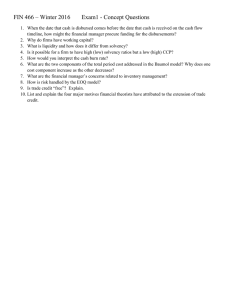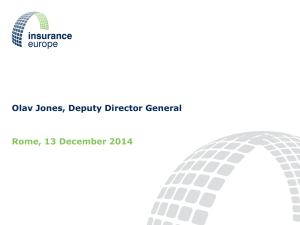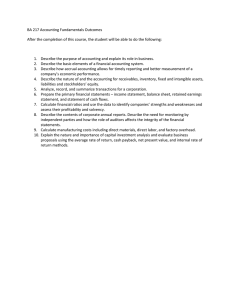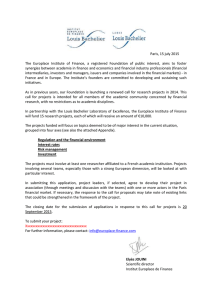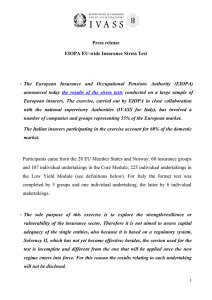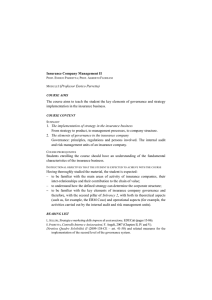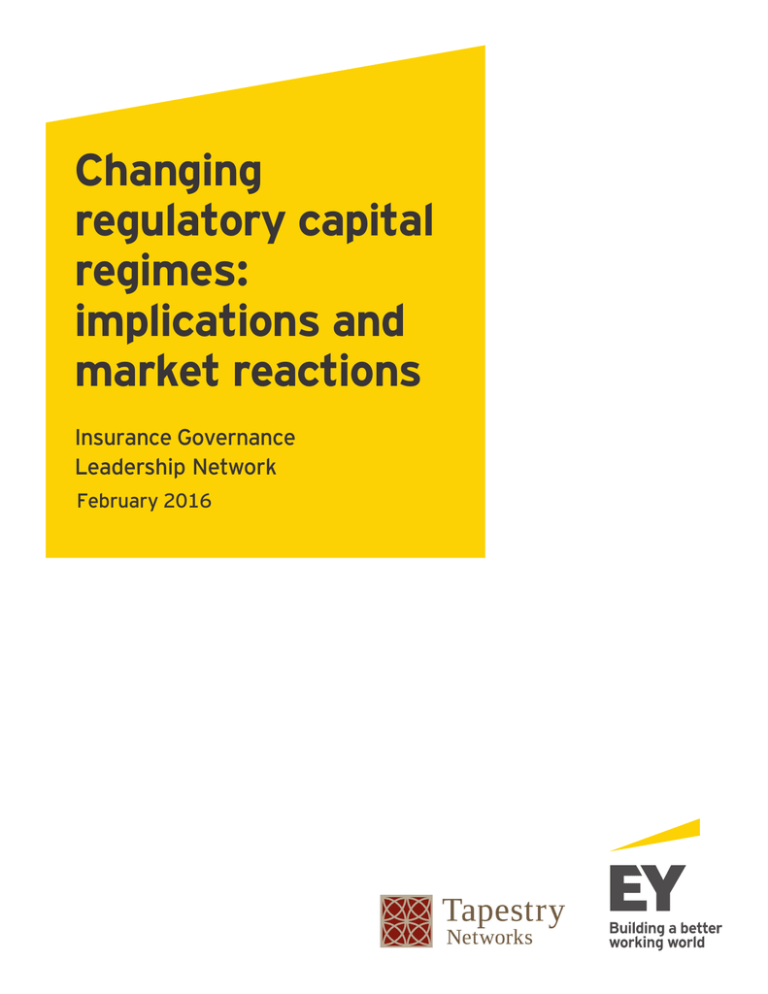
Changing
regulatory capital
regimes:
implications and
market reactions
Insurance Governance
Leadership Network
February 2016
ViewPoints
February 2016
Changing regulatory capital regimes: implications and market
reactions
In the last decade, the financial services sector has experienced a sea change in regulation and
supervision. Local, regional, and global authorities enacted a host of requirements intended
to modernize supervision and prevent many of the problems associated with the financial
crisis. However, many of the most significant insurance requirements are just beginning to
take shape. The European Union’s revised prudential regime for insurers, Solvency II, came
into force on January 1, 2016. And the International Association of Insurance Supervisors
(IAIS) and the Financial Stability Board (FSB) continue to advance the global supervisory
agenda through the drafting of capital requirements for systemically important insurers and
the insurance capital standard (ICS). Each of these regional and global work streams will
profoundly affect the largest insurers and are likely to prompt even more changes in existing
local regulatory regimes.
On December 8, non-executive directors, executives, and supervisors met in London to
discuss Solvency II’s pending implementation, the evolving IAIS agenda, and how markets
may react to new solvency requirements and metrics.
This ViewPoints1 provides a summary of these discussions and
is guided by the following questions:
How might Solvency II evolve in the next few years?
How are insurers translating value to investors in light of new solvency requirements
and metrics?
How might the global regulatory agenda evolve, and what challenges does it face?
As implementation of Solvency II begins, insurance groups and their supervisors will also start
the next phase of a long learning period. In the future, elements of Solvency II may require
adjustment. Furthermore, as global capital standards are developed and implemented in 2020,
policymakers may wish to better align the two regimes. Participants identified important
questions for supervisors to answer in the coming months and years and highlighted areas
where Solvency II may require adjustment.
How will equivalence be addressed?
Solvency regimes outside of the EU must apply and be assessed for equivalence with Solvency
II. To date, Switzerland has received a full equivalency determination and a handful have
obtained provisional equivalence.2 This raises questions about how capital in those
jurisdictions will be evaluated by group-level supervisors in the EU. One supervisor noted,
Insurance Governance Leadership Network
“We are in a halfway house on equivalence. Some equivalence is not fully in place yet, so
countries will continue to apply various fixes until they are not necessary.”
Participants also questioned whether some jurisdictions are truly equivalent. In response, one
supervisor, noting that so-called third countries (supervisory regimes outside of Solvency II)
open their books to obtain equivalency decisions, said, “Third countries have made many
reforms – especially to valuation – in order to obtain equivalence. I see room for further
improvement, but there have been great strides. It used to be if it comes from Europe, it
must be bad, but that is changing.” All participants noted that reconciling the European and
US solvency systems remains exceedingly challenging, but they were hopeful that, in spite of
accounting differences, the ICS might be part of the solution. However, with the
introduction of the ICS, some third countries may question whether their regimes need to
be Solvency II equivalent or simply follow the ICS.
Can supervisors ensure consistent application of Solvency II?
Despite the overarching framework, Solvency II allows for some national variation and for
the largest firms to determine capital levels according to individual internal models. Given
this variation, achieving meaningful cross-border consistency in regulation may prove
challenging. In the extreme, the allowance for local differences has provoked charges of
“gold plating” as certain local supervisors employ add-ons that increase standards or adjust
policies, rules, or procedures in ways insurers find overly restrictive. The European Insurance
and Occupational Pensions Authority (EIOPA) has a number of tools to encourage crossborder consistency, including guidelines, opinions, benchmarking of internal models, and, in
the future, development of a supervisory handbook. Sector participants are keen to see how
these tools, as well as direct conversations with authorities, will work in practice.
“Gold plating is not the
solution. We need a
sound basis and an
understanding by all
parties of how
regulation should be
implemented.”
– Supervisor
How will supervisors balance enforcement with the need for a learning period?
Both firms and supervisors face execution risk as Solvency II begins in earnest. Firms have
much work to do; however, as one director said, “There is a big risk in the supervisors
themselves. Are they really ready for Solvency II? Are they ready to manage these firms?
Will they be able to cope on an efficient basis?” Insurance groups also wonder whether
authorities will move quickly toward enforcement or be somewhat lenient and employ
forbearance as authorities and firms adapt to the new regime. One director said, “I hope
supervisors view the first year as a learning process and they don’t jump on us, demanding
lots of audits. There has to be some adjustment period for both sides.” Firms and supervisors
seem to agree that ample time will be needed for all parties to get up to speed.
How will Solvency II affect adaptability and business agility?
Firms are worried about two specific issues: (1) model error, where models misestimate
important risks, resulting in poor or slow decision making at the group level, and (2) the slow
process of updating models, which could inhibit good decision making as well. As one
director noted, “There are big seismic events that could make the model wrong. My concern
is that models don’t react quickly. You could underestimate the risk and hide behind rules
and models, which may be too procyclical.” In addition, changes to models require
regulatory approval, which may slow an insurer’s reaction times to a host of situations ranging
from capital events to mergers and acquisitions.
“There is a pendulum
in the history of
financial crises. In this
year, we have reached
the outside of what
can be agreed. We are
now entering a
calming period.
Supervisors may be on
defense.”
– Supervisor
Insurance Governance Leadership Network
How will existing weaknesses in Solvency II be addressed?
Regulators and industry participants widely acknowledge that elements of Solvency II will
need to change in the future. Lessons will emerge from implementation. Further, as one
supervisor noted, “Solvency II is 15 years old. When it was first thought about, it did not
contemplate ultra-low rates, focus on conduct versus prudential risks, technology, changing
customer behavior ... Is it still fit for purpose?” Participants made the following suggestions
for early revisions to Solvency II:
Reduce complexity. Supervisors and insurers agreed that Solvency II may be ripe for
simplification. One director suggested, “Reducing complexity is in the interest of all
groups – insurers, regulators, etcetera. We should compare important matters, not small
rules. At the end of the day, what counts from a capital perspective is that you are above
the regulatory standard.” A supervisor agreed, noting that insurers and supervisors were
“Solvency II has a
number of
weaknesses.
How will regulators
address those?”
– Director
likely to find common ground on the issue of complexity, whereas regulators may be less
willing to adjust capital rules. One director suggested that reporting and metrics might
be an area in which to seek simplification: “Solvency II figures will take over for market
-consistent-embedded-value reporting … Results will be similar. It would be helpful to
get rid of one set of metrics.” However, another participant cautioned, “If you are just
going to report Solvency II and not embedded value, you are not going to show the true
value creation of some of these business models. I’m cautious about giving up some of
these metrics.”
Adjust the risk margin3 to minimize volatility. The consensus among IGLN
participants is that markets and insurer balance sheets will be more volatile in the future.
Solvency II, itself, is more volatile than previous regimes. Observers point to the risk
margin and swap spread as areas of particular concern with respect to volatility. The
margin is sensitive to interest rates, creating challenges for insurers with exposure to
longevity risk. Insurers are exploring strategies such as hedging (via derivatives) or
reinsurance to manage the risk margin.4 “The risk margin is bigger and more volatile
than expected,” said one director. “It creates a need to hedge volatility, and that’s strange
because you don’t typically hedge your own capital.” Another said, “You are either
hedging something that doesn’t exist, which creates earning-statement volatility, or you
don’t hedge and you have huge capital-base volatility impacting your ability to make
dividends.” Several supervisors, including Sam Woods of the Bank of England, have
suggested that modifying the risk margin calculation may provide some relief.5
Address specific weaknesses. IGLN participants raised a number of technical
concerns, including the unrealistic basis for forward curves, the treatment of periodic
payment orders,6 accounting for reinsurance premiums,7 capital treatment related to credit
risk and corporate bonds,8 and a host of other issues that are ripe for discussion and,
perhaps, adjustment in the future.
Refine internal-model governance. Boards continue to adjust expectations for
governance of internal models. Participants discussed a number of common practices,
including intensive risk and audit committee model reviews, external validation by
experts, deep dives into model elements, and including actuarial talent on the board. A
supervisor also cautioned that leadership should be sensitive to whether models become
less accurate over time. This is “the analytical question of drift. Does the model drift
“Volatility in the
system is not artificial.
It is there. It is the
market reaction to the
perceived volatility
that can be artificial.
What is the best way
to address that?”
– Policymaker
Insurance Governance Leadership Network
over time?” As insurers and regulators adjust to internal models, firms may continue to
revise model governance.
Address possible procyclicality. On December 16, the European Systemic Risk
Board (ESRB) – a group widely known for its work in banking, not insurance – published
a report arguing that insurers contribute to systemic risk via procyclical investment
behavior.9 To offset procyclicality, the report calls for countercyclical buffers, which
would accumulate capital in healthy markets and release it in periods of stress. The report
also calls for enhanced liquidity supervision. Insurers have disputed the findings of the
report.10 The ESRB does not have formal regulatory authority, but the report may
demonstrate how regulators are thinking – namely, that the synchronized behavior of
smaller institutions may create risks just as the so-called too-big-to-fail institutions can.
The report was published just weeks before implementation of Solvency II, a regulation
that many say may worsen procyclicality via the use of mark-to-market accounting and
one-year value-at-risk capital charges. These requirements and others may encourage
firms to hold similar assets and have shorter investment horizons.
Among the goals of the solvency capital requirement (SCR) under Solvency II is to make
firms more comparable. Insurers and supervisors believe that, over time, ratios and new
reporting requirements will improve comparability, even if the SCR is not yet fulfilling this
goal. One participant summarized the current situation: “It may be a bit of apples to oranges,
but at least we are all consuming fruit.” Currently, however, investors, analysts, firms, and
supervisors recognize that there is a lot of confusion about what solvency ratios mean and
how markets will respond.
One participant asked, “Does a ratio of 200% mean the same thing in France and Germany?
Clearly, that is not the case.” Another asked, “Is a high ratio a good thing because you are
in a good capital position, or a bad thing because you are overcapitalized?” Some stakeholders
wonder if ratios could presage cost reductions, special dividends, or other actions. Insurers
have expressed concern that, as one director put it, “investors boil things down to one
number and make snap judgments.” Insurers will need to make their cases to analysts and
investors, the ultimate interpreters of these measures, about why their ratios are appropriate.
Important messages from the analyst community
On January 19, Prudential joined Allianz, AXA, and Aegon in announcing its SCR.11 In the
coming weeks and months, many firms will follow. Firms are keen to understand how
markets may view these ratios. Discussions with several analysts and investor relations
professionals raised the following themes:
Firms should expect scrutiny but not be too concerned by it. “Headline risk
exists, but it is short term … the SCR is not the ‘be all, end all,’” said one participant.
Furthermore, markets have always struggled with insurance balance sheets: “Balance sheet
complexity is reflected in a discount in the share price,” argued another participant.
Markets will react to SCR reporting but ultimately will look to more than a simple
number to understand a group’s value.
“The market is
nervous. There is
uncertainty on
Solvency II and how
the market will
respond.”
– Director
Insurance Governance Leadership Network
Analysts are focused on each organization’s value drivers. Participants agreed
that, at the highest level, investors want clear disclosures on how capital is generated and
how it is used (e.g., organic growth, mergers and acquisitions, dividends). Furthermore,
markets will want a clear sense of future value creation, not just a point-in-time view.
One participant asked, “Is value front loaded in the SCR now, or will it come out over
time?” Share price will favorably reflect future value, which may also be a function of
business model flexibility. Those insurers who can reprice or change terms may be in a
better position than those who cannot.
A firm’s trustworthiness and reputation will influence market reactions. One
participant cautioned, “If you don’t have credibility, it will take years to build. Consistent
communication helps the market to understand. Analysts can’t recalculate Solvency II
numbers. You can’t just update something and say, ‘This is how much capital a company
should have.’ It is a bespoke calculation. Markets will look at what companies do, not
just what they tell you. It tells you more about their capital position than the actual
number.” Investors will look at how companies act (i.e., dividend policy, mergers and
acquisitions, or divestment decisions) to confirm the narratives that groups put forth.
Disclosures are simplistic but will evolve quickly. “As we move from the lab to
the real world, we will learn quickly – firms, analysts, and supervisors,” said one executive.
Currently, typical disclosures reflect the quantum, not the quality, of capital and this may
change over time. “Quality of capital is not yet thought about. We don’t have that level
surpluses is everyone
of disclosure. We are lucky if we get Tier I, Tier II, and Tier III. That is the level of
granularity. At some point, that will improve,” said one participant.
of the 1-in-200-year
Diversity may not counter volatility sufficiently. Some market observers caution
that the assumed diversity benefit may be insufficient in times of stress when different
assets can become more correlated. One participant noted, “One issue with Solvency II
is that diversification may get pushed to the extreme. Analysts worry that insurers are
given too much credit for diversification and accept volatility. Analysts worry when they
see diversification on capital market risks. If you look at the Asian crisis, the dotcom
burst, 2008, you start to question diversity credit.”
Variations in the use of transitional measures and accounting standards will
complicate disclosure. The transitional measures allow insurance groups up to 16 years
to phase in technical provisions of Solvency II, allowing for a smoother transition. There
is some disagreement among geographies as to the merits of transitionals. For example,
UK insurance groups and the Prudential Regulatory Authority (PRA) are generally
supportive of their use, while many insurers and supervisors in continental Europe are less
supportive. IGLN participants questioned how firms should disclose the use and value of
these measures, and how markets will react. One director asked, “Does your solvency
number include transitional measures or exclude them? If you exclude them, the result
could be completely different. This should matter to the market as well. Investors don’t
know enough to evaluate this.” In speaking to this point, Sam Woods recently noted
that the PRA will include use of transitionals in calculations of capital adequacy and ability
to dividend:
“What sort of
expecting? We are
required to take care
event. What do the
regulators or the
markets really
expect?”
– Director
Insurance Governance Leadership Network
With rates where they are, the risk margin is currently large for UK life insurers.
In the near-to-medium term, transitional measures absorb the impact of this – and
I would like to repeat what I said in July: the Bank will allow full use of transitional
measures by those firms that qualify to use them. And when we consider whether
or not firms are in a position to pay dividends, one of the main quantitative
yardsticks we will use is capital levels after the benefit of transitionals.12
Insurers also worry that they will have to reconcile performance and capitalization under
many different accounting and solvency regimes. One director said, “Solvency II, the [ICS],
IFRS [International Financial Reporting Standards], GAAP [generally accepted accounting
principles] – there are dozens of required formats explaining the same companies with
different metrics and realities.” Another agreed, noting, “Perhaps there is an issue of claims
reserving, assets, or premiums – local GAAP versus IFRS. Then the public asks for alignment
at the shareholder meetings, and it is impossible to provide.”
Steps stakeholders can take to improve market understanding of SCR
Insurers operating under Solvency II are now focused on improving communication with
the market. As metrics change and firms feel less able to anticipate market responses, IGLN
participants identified activities different stakeholders can undertake to improve outcomes for
individual firms and the sector:
Individual firms need to articulate the specifics of the business and internal
models. To meaningfully explain value drivers, insurers will need to help markets
understand how internal models work and how business model choices affect the solvency
ratio. One supervisor suggested, “Companies should do the same exercise with investors
“Everyone wants to
understand – will it
as with regulators. Explain how the models work. What are strengths and weaknesses?”
affect the dividend?
So-called “outlier firms,” or those with more unique business models (e.g., significant
closed books of business or banking operations), may have the most work to do in this
area.
Do you need to raise
Firms should collaborate to underscore broad principles. Firms will need to
explain their own SCRs, but they also should collaborate to communicate key themes to
the markets. “There are a few key principles: one size does not fit all; you can’t rank and
stack groups; and it is not an arms race – you do not get a gold star for a capital ratio of
250%,” said one participant.
Insurers should clearly define the board’s role. “Direct communication falls to
management, but the board should be closely following market communications as we
transition to new regimes,” said one director. Several directors indicated their boards are
involved in developing, approving, or advising on new communications strategies. When
asked about how individual board members can add the most value, one director
suggested, “Good questions for the board are ‘What challenges does your CFO have? Are
you aware of the main issues around capital? Do you understand the basics of the various
methodologies?’” One participant cautioned, “It is important for the board to stay on
top of this. Don’t let the tail wag the dog. Mechanics need to be understood. There are
huge amounts of technical information.”
capital? It is not black
and white.”
– Director
Insurance Governance Leadership Network
Supervisors have a role in explaining the regime to the market. Participants
agreed with one supervisor who observed, “We do have a responsibility to explain the
regime. We pick a few messages and try to hammer them home. We make sure analysts
understand what we are thinking, but it is not a job for us to do the investor relations for
a firm.” Specifically, participants agreed that supervisors could underscore that solvency
ratios will move for two reasons, with very different implications for investors. Ratio
movements due to market swings may be far less significant than movements related to
underlying weaknesses in the business.
“Is safety and
Insurers with European operations have been extremely focused on the implementation of
Solvency II; however, the IAIS agenda, including the development of the ICS and additional
regulations for global systemically important insurers, also continues to move forward.
Participants broadly agreed with the need for an international capital standard and, to a lesser
extent, new requirements for systemically important insurers. One participant observed,
“Because insurers are global, we need a global solution. It is in insurers’ interest to have a
comparable standard because they are only becoming more global.”
soundness of the
group relevant?
If you believe that, it is
hard to say you are
against a global
standard.”
– Supervisor
However, directors have many questions and ideas about standards development. Over the
discussion, participants discussed tactical implementation questions and shared concerns about
new standards. The following themes emerged:
ICS implementation will begin in 2020, with a long transition period. The first
basic standards will be developed by 2017. More concrete standards, which consider
internal models, will be developed by 2019, and implementation begins in 2020.
Participants and other observers have noted that while implementation is several years off,
this timeline is far shorter than timelines used to develop comparable banking standards
or Solvency II measures. Insurers are somewhat concerned that quick development could
inhibit meaningful debate and industry engagement in the process.
Stakeholder pressure will facilitate ICS adoption. The ICS must be adopted locally,
so full adoption will take time and be subject to local pressures. One director observed,
“You have to get regulators to agree. You need to get political buy-in country by
country. You could get a lot of opposition on accounting standards. You need to get
parliaments to approve. They have to have a reason to get behind it. To get them to
abandon an existing regime is quite an endeavor.” To help facilitate broad adoption, one
policymaker said, “The intention is not just reporting to regulators, but to the markets,
including credit rating agencies and investors. They will create market pressures to use
the measures.”
The ICS will be lower than some national standards. Unlike Solvency II, which
raised capital requirements, the goal of the ICS is to create a new global minimum
standard. Accordingly, the standard will be lower than some existing national standards.
One supervisor said, “The goal is not raising capital; it may be lower in some areas, but
globally harmonized. Consistent capital is the goal … Standards will be low and up to
the national regulators to add on. A higher bar would make approval harder. Minimum
capital is the goal.”
“The ICS will come.
There are a lot of
difficulties in how it
comes. The target is
2020.”
- Policymaker
Insurance Governance Leadership Network
Valuation differences are the biggest hurdle to ICS implementation. A global
standard must accommodate the methodologies and principles that guide Solvency II, as
well as US valuation of liabilities and risk-based capital standards. Participants widely
agreed that this is the largest hurdle to development of a meaningful ICS. Unfortunately,
given the lack of convergence in accounting standards, some participants view a global
capital standard as all but impossible. One policymaker acknowledged, “There is an
enormous challenge when regulating accounting issues. If you could agree on US and
European accounting convergence, then more than half of the work is done.”
“The key challenge is
accounting and
valuation, valuation,
valuation.”
– Supervisor
To resolve this challenge, the IAIS is not committing to a single valuation approach but
to, in the words of a policymaker, “trying to make a more comparable valuation … The
goal is to make GAAP and market-adjusted data converge and make them reconcilable.”
One director asked, “Does the IAIS engage with accounting authorities? Your
supervisory authorities need to speak.” Supervisors acknowledged that supervisory
regimes do communicate, but given different mandates, agreement can be difficult to
achieve. Like Solvency II, “ICS will not wait for accounting convergence. It would be
helpful, but the agenda is the agenda. The IAIS will not wait,” a policymaker said. One
supervisor noted the challenging environment but concluded optimistically, “It is a bit
unfortunate that the debate on global ‘systemic-ness’ got bound up with the ICS debate.
The bigger prize is ICS. The globally systemic approach is bringing fears that banking
regulation is coming across to insurance. We have broadly managed to get to convergence
in banking - Basel III, Capital Requirements Directive IV - so it must be possible for
insurance.”
Insurers support a global standard but worry about the proliferation of multiple
standards. Insurers are concerned that in 2020, as a result of the ICS and other regulatory
changes, they will face even more standards, as well as greater complexity and expense.
One audit chair noted, “There is Solvency II, ICS, and also [IFRS 4 Phase 2] coming
into place by 2020. These are at least three new standards and separate reporting
requirements at that time. Then add to that ratings agencies, [market-consistent
embedded values] … How many measures are enough?” Another participant asked, “So
when does Solvency II cease? If the ICS is relevant and has teeth, it should replace what’s
there.”
Local standards, including Solvency II, may shift to accommodate the ICS. It
is too early to predict areas where existing regimes may conflict with the proposed ICS.
However, many observers note that local regulatory regimes may have to adjust to
accommodate the global standard. Insurers and local supervisors will be somewhat
resistant to this given the sunk costs associated with Solvency II and other regimes.
However, one European policymaker remarked, “We want to be part of the solution.
We are willing to make adjustments to Solvency II for the convergence of local, regional,
and international standards, but we have some red lines.”
***
As insurers become more global, boards find themselves in the unique and challenging
position of having to understand the entire global regulatory picture. Prudential regulators
are focused on policyholders and taxpayers within their jurisdictions. Even at the level of the
“Transatlantic
convergence is the key
to global convergence.
If we address
transatlantic
convergence, it is a
huge
accomplishment.”
– Policymaker
Insurance Governance Leadership Network
IAIS, the main stakeholders are local regulatory authorities. As Solvency II demonstrates,
boards must balance the interests of supervisors, shareholders, and the broader public.
Balancing these interests while building competitive, sustainable insurers is a significant task.
In theory, as regulations and supervisory expectations converge across jurisdictions via
regional and global standards, the functioning of insurance markets as well as opportunities
for sectoral and economic growth will improve.
The perspectives presented in this document are the sole responsibility of Tapestry Networks and do not necessarily reflect the
views of any individual financial institution, its directors or executives, regulators or supervisors, or EY. Please consult your
counselors for specific advice. EY refers to the global organization, and may refer to one or more of the member firms of Ernst
& Young Global Limited, each of which is a separate legal entity. Ernst & Young Global Limited, a UK company limited by
guarantee, does not provide services to clients. This material is prepared and copyrighted by Tapestry Networks with all rights
reserved. It may be reproduced and redistributed, but only in its entirety, including all copyright and trademark legends.
Tapestry Networks and the associated logos are trademarks of Tapestry Networks, Inc. and EY and the associated logos are
trademarks of EYGM Ltd.
Insurance Governance Leadership Network
Over the autumn of 2015, Tapestry and EY held conversations with directors, executives,
regulators, supervisors, and other thought leaders on the implementation of Solvency II and
the evolving global capital agenda as led by the IAIS. These discussions culminated in the
meeting on December 8 in London. Insights from these discussions informed this
ViewPoints and quotes from these discussions appear throughout. The following individuals
participated in IGLN discussions:
Alastair Barbour, Audit Committee,
Risk Committee, Investment
Committee, Nomination and
Governance Committee Member,
RSA
Paul Bradshaw, Customer Interest,
Audit, Actuarial and Finance, Risk
and Compliance Member, Sanlam
Richard Burden, Managing Director,
Credit Suisse
Marcia Campbell, Audit Committee,
Risk Committee Member, CNP
Assurances
John Fitzpatrick, Risk and Capital
Committee Chair, Audit Committee
Member, AIG
Raghu Hariharan, Director of
Investor Relations, Prudential plc
Ingrid Johnson, Group Finance
Director, Old Mutual
Sabrina Pucci, Non-Executive
Director, Generali
Raj Singh, Group Chief Risk Officer,
Standard Life
Kory Sorenson, Audit Committee
Chair, Strategic, Risk, Crisis
Management Committee Member,
Scor
Terry Stone, Regulatory,
Compliance, and Public Policy
Committee Chair, Audit Committee
Member, AIG
Tim Tookey, Risk Committee Chair,
Nationwide Building Society
Ben van der Veer, Audit Committee
Chair, Nominating Committee
Member, Aegon
Sam Woods, Executive Director of
Insurance Supervision, Bank of
England
Yoshi Kawai, Secretary General, IAIS
Sue Kean, Chief Risk Officer, Old
Mutual
Martin Bradley, Global Insurance
Finance, Risk, & Actuarial Leader
Monica Mächler, Audit Committee,
Risk Committee Member, Zurich
Shaun Crawford, Global Insurance
Leader
Roger Marshall, Audit Committee
Chair, Risk Committee,
Remuneration Committee Member,
Old Mutual
Ed Jervis, Partner, EMEIA Financial
Services, Insurance
Carlos Montalvo, Executive Director,
EIOPA
Andrew Palmer, Audit Committee
Chair, Direct Line Group
Leah Daly, Principal
Colin Erhardt, Associate
Peter Fisher, Partner
Insurance Governance Leadership Network
ViewPoints reflects the network’s use of a modified version of the Chatham House Rule whereby names of network participants and their corporate
or institutional affiliations are a matter of public record, but comments are not attributed to individuals, corporations, or institutions. Network
participants’ comments appear in italics.
2 Switzerland has received a full equivalence determination. Australia, Bermuda, Brazil, Canada, Mexico and the US received provisional equivalence
for a period of 10 years.
3 The risk margin is a capital buffer designed to cover the cost to pay a third party to take on a failed insurer's liabilities if put into runoff.
4 Callum Tanner, “Hedge, Reinsure or Restructure: Insurers Mull Risk Margin Fixes,” Risk.net, December 11, 2015.
5 Sam Woods, “Solvency II: Approaching the Try Line” (speech, Association of British Insurers, London, November 3, 2015).
6 Periodic payment orders are typically court-awarded, annuity-like arrangements for individuals who become permanently disabled. For a number of
years, their use has been growing in several jurisdictions, including the United Kingdom. They require property-casualty insurers to provide for longterm liabilities. Treatment under Solvency II requires insurers to shift between property-casualty and life insurance capital requirements.
7 Some participants worry that there is a mismatch in the treatment of reinsurance premiums. Primary insurers pay for the upcoming year and anticipate
a degree of recovery. However, under Solvency II, insurers must expense occurring premiums with no matching adjustment or allowance for
recovery. As a result, some primary insurers are asking for shorter reinsurance terms. In addition, for reinsurers the premium becomes a capital buffer.
8
For more information, see Danielle Myles, “Solvency II Treats Insurers Like Traders,” International Financial Law Review, November 11, 2015.
9
European Systemic Risk Board, Report on Systemic Risks in the EU Insurance Sector (Frankfurt, Germany: European Systemic Risk Board,
December 2015).
10 Callum Turner, “UK Insurance Association Slams ESRB Report,” Risk.net, January 13, 2016.
11
Prudential, “Prudential plc Solvency II Capital Position,” news release, January 19, 2016.
12 Sam Woods, “Solvency II: Approaching the Try Line.”
1

